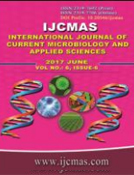


 National Academy of Agricultural Sciences (NAAS)
National Academy of Agricultural Sciences (NAAS)

|
PRINT ISSN : 2319-7692
Online ISSN : 2319-7706 Issues : 12 per year Publisher : Excellent Publishers Email : editorijcmas@gmail.com / submit@ijcmas.com Editor-in-chief: Dr.M.Prakash Index Copernicus ICV 2018: 95.39 NAAS RATING 2020: 5.38 |
The upland cotton (Gossypium hirsutum L.) accounts for about 95% of world cotton production. Improving upland cotton cultivars has been the focus of world-wide cotton breeding programs. In cotton, seed cotton yield, yield contributing and fibre quality traits are under the control of polygenes or quantitative trait locus (QTL), for these traits QTL analysis holds a great promises these are the genomic regions that links the information between phenotypic (trait measurement) and genetic data (molecular markers) and explain the genetic basis of variation in complex traits. The development of appropriate molecular markers in the background of suitable mapping population and construction of genetic linkage maps and QTL identification using statistical programs are earnest for QTL mapping. Present review provides an updates on comparative QTL analysis to obtain a better insight into the genome-wide distribution of QTL and to identify consistent QTL for marker assisted breeding and marker-assisted QTL manipulation to the genetic improvement of quantitative traits in cotton.
 |
 |
 |
 |
 |